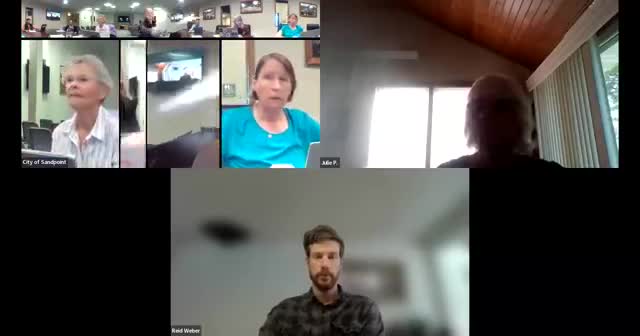Sandpoint advisory committee endorses multimodal recommendations for O'Connell Estates subdivision
October 10, 2025 | Sandpoint, Bonner County, Idaho
This article was created by AI summarizing key points discussed. AI makes mistakes, so for full details and context, please refer to the video of the full meeting. Please report any errors so we can fix them. Report an error »

The Sandpoint Pedestrian and Bicycle Advisory Committee on Oct. 9 agreed to concur with the committee subcommittee's recommendations for the preliminary O'Connell Estates subdivision, a residential development along Woodland Drive north of Samuelson and east of Boyer.
The committee’s comments asked the applicant and city staff to prioritize multimodal connectivity and specific frontage improvements along Woodland Drive. Staff and committee members emphasized tying any new walkway to the city’s Multimodal Transportation Plan and to nearby active projects, including the Samuelson development and the planned Great Northern corridor connections.
Key recommendations the committee endorsed included: a paved multiuse pathway from the new cul‑de‑sac toward Samuelson (recommended 10–12 feet, and committee members discussed 12 feet as a minimum for multiuse segments); sidewalks on Woodland Drive with a curved ramp at Beaver Avenue; curb ramps facing both directions at the outlet to Holstein Place; metal truncated dome panels at curb ramps for durability; and installation of rapid rectangular flashing beacons (RRFBs) either at Boyer and Woodland or as two mid‑block RRFBs near Jersey and Samuelson to help pedestrians cross the busy truck route.
Committee members also recommended stripe bike lanes on Woodland Drive where feasible and asked staff to consider a street section that combines a multiuse path and parallel bike lanes so that both commuter cyclists and people using the multiuse facility have options. Eric Brubaker, associate planner and staff liaison, said the committee should weigh alignment and connectivity “and note that what the plan is saying there is that we need that connection for multimodal connectivity and circulation.”
Reed Weber announced an abstention from the O'Connell item. The committee then voted to record and forward the subcommittee recommendations; the chair asked that the recommendations be included in the minutes for the record. Staff noted that public works and planning engineering will review the technical feasibility of roadway width, grades and right‑of‑way needs before final design and construction commitments.
The committee’s recommendations are advisory: the city’s public works and planning departments will evaluate technical and cost constraints, and final requirements will be set through the development review and any council approval process. The developer committed, in previous review comments, to set aside funding for a crosswalk where a future connection exists; committee members asked that any funded but unbuilt crossings be tied to future connections so the funded elements remain usable when the time comes.
Staff said the committee’s points would be compiled in the meeting minutes and transmitted to the applicant and relevant city review groups for consideration.
The committee’s comments asked the applicant and city staff to prioritize multimodal connectivity and specific frontage improvements along Woodland Drive. Staff and committee members emphasized tying any new walkway to the city’s Multimodal Transportation Plan and to nearby active projects, including the Samuelson development and the planned Great Northern corridor connections.
Key recommendations the committee endorsed included: a paved multiuse pathway from the new cul‑de‑sac toward Samuelson (recommended 10–12 feet, and committee members discussed 12 feet as a minimum for multiuse segments); sidewalks on Woodland Drive with a curved ramp at Beaver Avenue; curb ramps facing both directions at the outlet to Holstein Place; metal truncated dome panels at curb ramps for durability; and installation of rapid rectangular flashing beacons (RRFBs) either at Boyer and Woodland or as two mid‑block RRFBs near Jersey and Samuelson to help pedestrians cross the busy truck route.
Committee members also recommended stripe bike lanes on Woodland Drive where feasible and asked staff to consider a street section that combines a multiuse path and parallel bike lanes so that both commuter cyclists and people using the multiuse facility have options. Eric Brubaker, associate planner and staff liaison, said the committee should weigh alignment and connectivity “and note that what the plan is saying there is that we need that connection for multimodal connectivity and circulation.”
Reed Weber announced an abstention from the O'Connell item. The committee then voted to record and forward the subcommittee recommendations; the chair asked that the recommendations be included in the minutes for the record. Staff noted that public works and planning engineering will review the technical feasibility of roadway width, grades and right‑of‑way needs before final design and construction commitments.
The committee’s recommendations are advisory: the city’s public works and planning departments will evaluate technical and cost constraints, and final requirements will be set through the development review and any council approval process. The developer committed, in previous review comments, to set aside funding for a crosswalk where a future connection exists; committee members asked that any funded but unbuilt crossings be tied to future connections so the funded elements remain usable when the time comes.
Staff said the committee’s points would be compiled in the meeting minutes and transmitted to the applicant and relevant city review groups for consideration.
View full meeting
This article is based on a recent meeting—watch the full video and explore the complete transcript for deeper insights into the discussion.
View full meeting